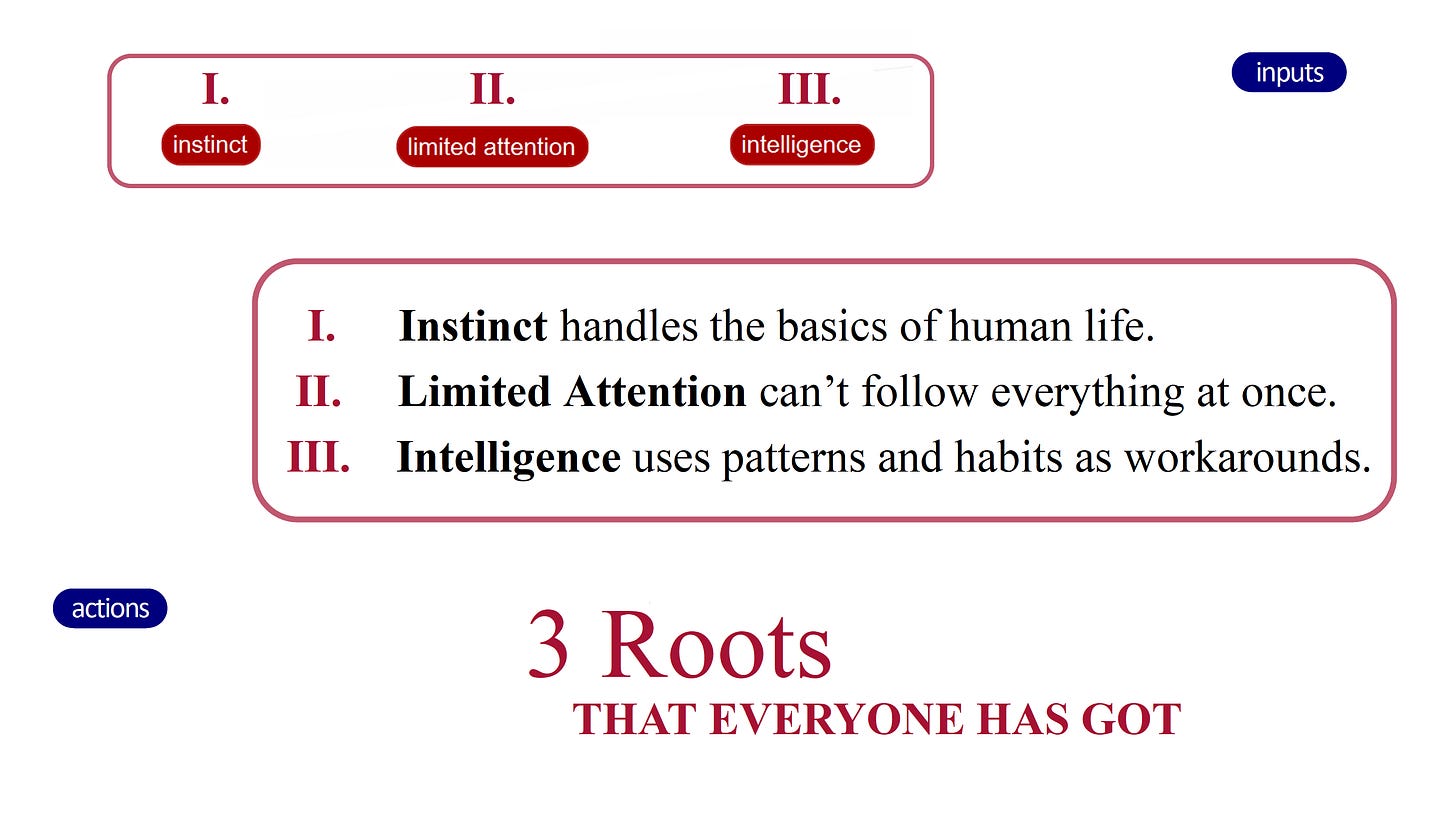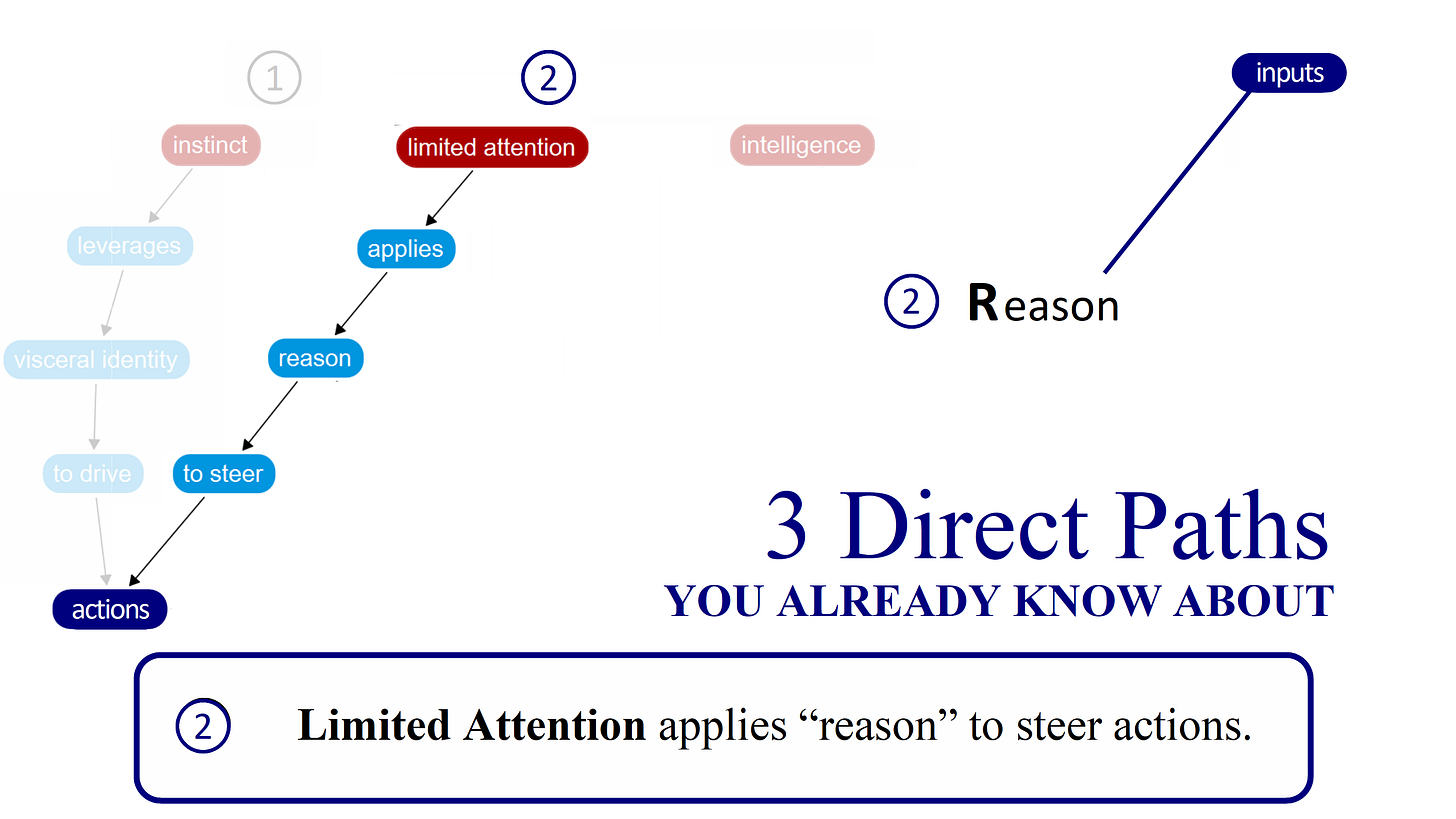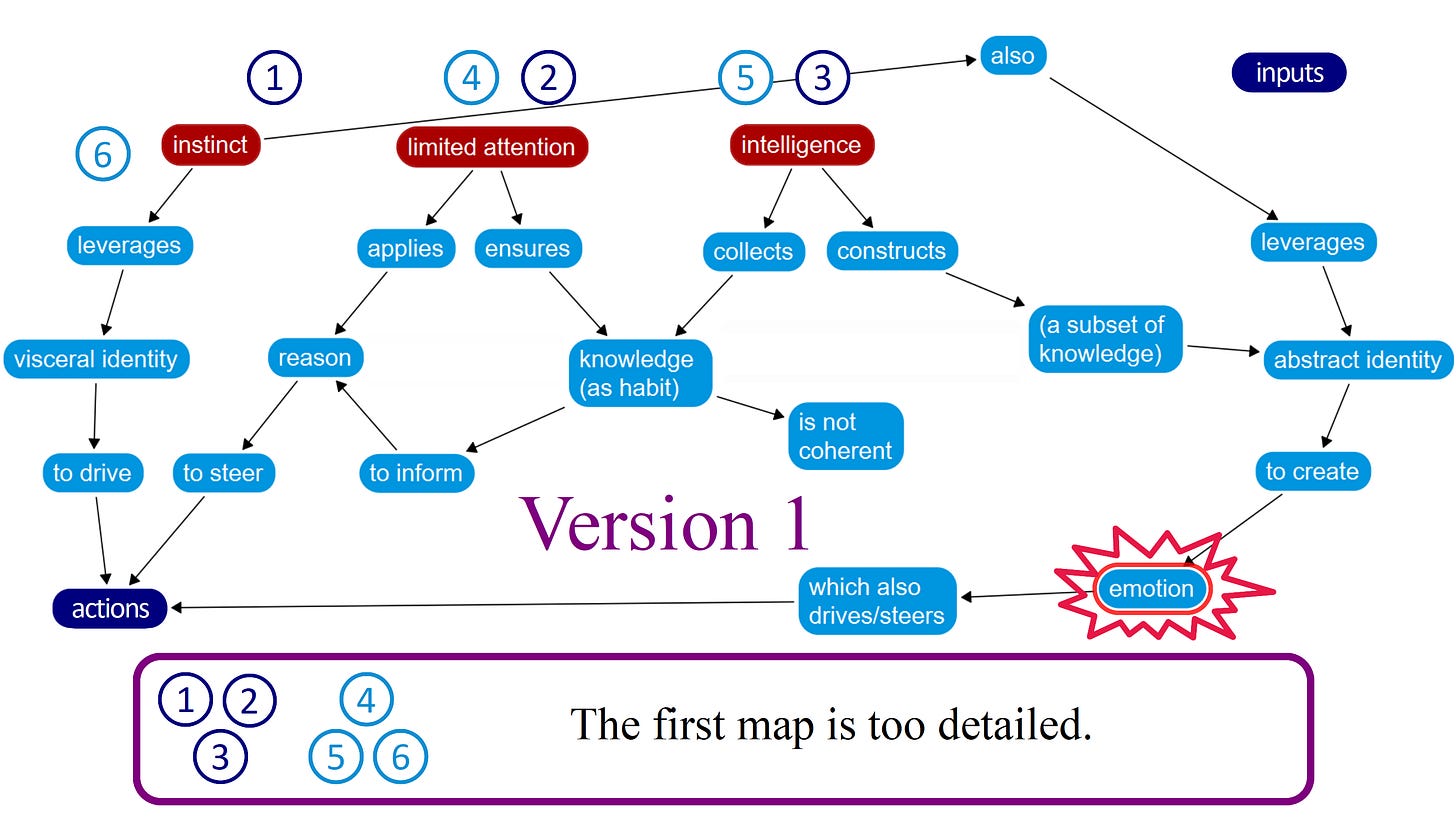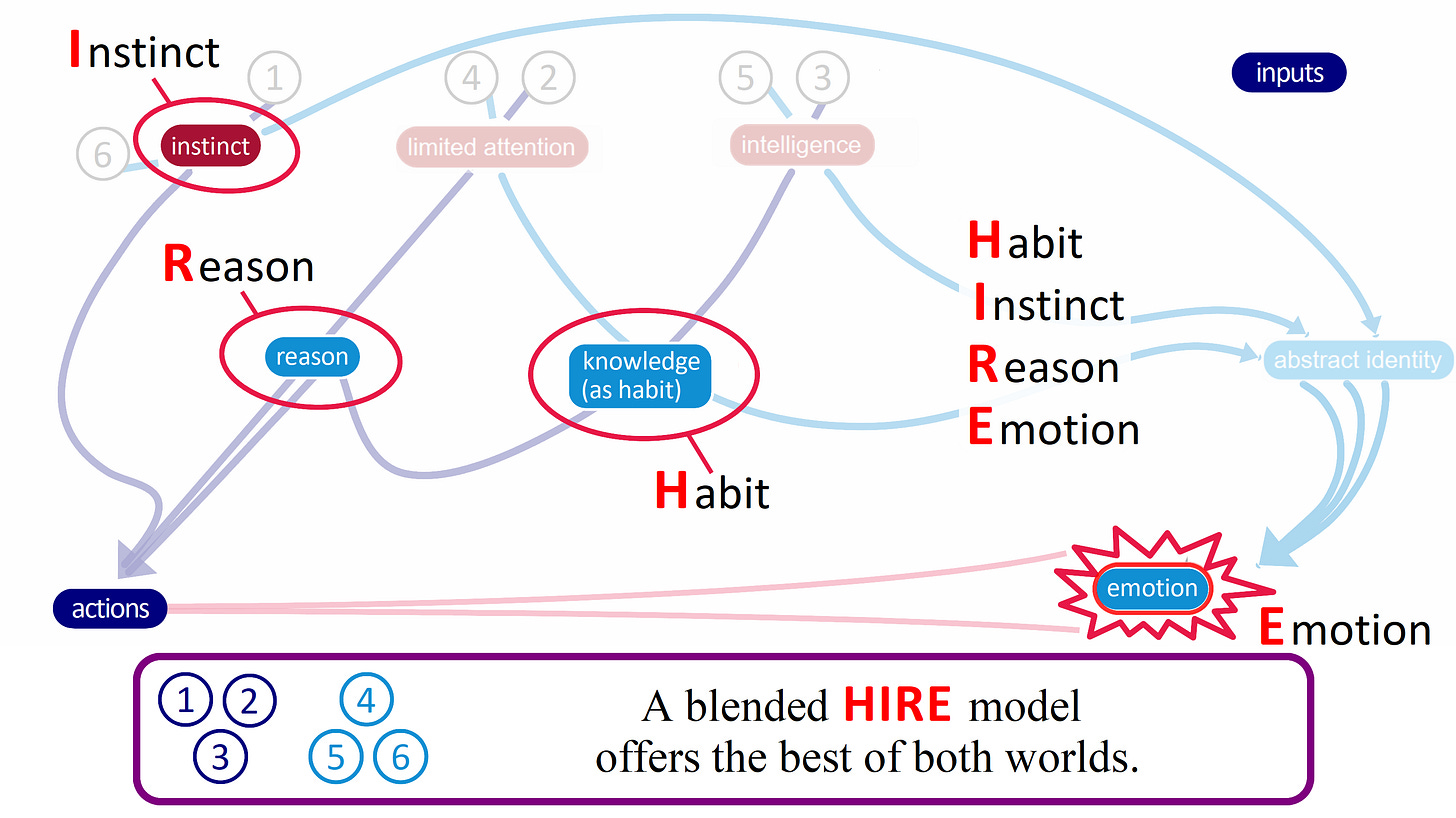Mapping the Mind
A sneak peek at Week 2
Introduction
The internet broke argument (and politics) by opening a window into how people REALLY think. Most people find this terrifying.
The solution is to open Pandora’s box WIDER, and find Hope.
My courses teach five box-opening skills:
Fix Argument
Map Decision-Making (YOU ARE HERE)
Find Hope
Change Actions (not just Ideas)
Fix Politics
We fixed Argument, in order to map how people REALLY think…
But one can be used to map the other.
Decision-making is “the entire mindspace between inputs & actions.”
I map that mindspace, build a better model, and walk you through its controls.
You will learn how to craft Arguments that target each of decision-making’s four main levers: Habit, Instinct, Reason, and Emotion (HIRE).
I. Deep Roots
“Everyone has got Instinct, Limited Attention, and Intelligence.”
When setting up a sweeping argument,
Use broad definitions. The broader, the better.
Stick to simple language.
Make it easy for people to say “YES, I WHOLE-HEARTEDLY AGREE, and now I’m curious where you’re going with this.”
Get on the same page FIRST, then argue.
Decision-making is the entire mindspace between inputs & actions. That mindspace has three universal, self-evident roots:
“Everyone has got Instinct, Limited Attention, and Intelligence.”
Did you buy in? ☐ YES ☐ NO
II. Six Universal Pathways
1. Instinct
Each human body comes pre-equipped with a baked-in, hardwired, felt sense of visceral identity.
Our instincts push against it to change our behavior.
Frank felt his knee give out, so he started limping.
Sheila felt nauseous, so she walked faster.
The baby felt hungry and thirsty, so he wouldn’t take his nap.
Feelings of pain, fear, nausea, hunger, thirst, and exhaustion accumulate in our bodies, one piled on top of another, until their combined pressure makes us decide to act.
That makes Instinct a major player in human decision-making.
“Instinct leverages visceral identity to drive actions.”
Instinct is the “I” in the HIRE model.
Did you buy in? ☐ YES ☐ NO
2. Limited Attention
Each human mind comes pre-equipped with a limited sense of attention.
We use it to plan our priorities, reason through problems, and try new things.
Frank is studying lawnmower repair.
Sheila is test-driving a faster route to work.
The baby wants his favorite book.
“Limited Attention applies reason to steer actions.”
Reason is the “R” in HIRE.
Did you buy in? ☐ YES ☐ NO
3. Intelligence
Intelligence expands the reach of Limited Attention by collecting vast piles of knowledge.
This knowledge is stored as habits of thought and of action.
Josh can solve a Rubik’s Cube in 60 seconds.
Sarah can recite Shakespeare from memory.
Jared knows cars, he can fix anything.
“Intelligence collects knowledge (which is stored as habit) to inform reason (to help steer actions).”
Habit is the “H.”
Did you buy in? ☐ YES ☐ NO
Direct Paths Summary
Instinct drives decision-making.
Limited Attention adds Reason.
Intelligence adds Habit.
But something is missing.
The HIRE decision-making model needs one more letter.
To find it, we’ll need a second set of pathways.
4. Incoherence
Each human mind stores vast amounts of personal knowledge as habits of thought and of action.
Limited Attention can’t check all of your habits at once. THis gives “total personal knowledge” its characteristically tangled shape.
Persistent patterns turn into local habits: That worked, I’ll keep doing it.
Successful habits turn invisible: She finished her coffee without noticing.
Local habits turn into global tangles: Which method works better here?
We simply switch habits as needed: Driving in snow, in sun, in floods, in mountains, in traffic jams...
Total personal nowledge is a tangle, not a spreadsheet.
“Limited Attention ensures that knowledge cannot be made fully coherent.”
Did you buy in? ☐ YES ☐ NO
5. Identity
Second-to-last path.
Each human mind constructs a vast, sprawling sense of abstract identity.
MY family, MY friends, MY home, MY money,
MY city, MY state, MY tribe, MY country,
MY music, MY politics, MY career, MY religion,
MY childhood, MY enemies, MY legacy, MY, MY…
Since abstract identity is knowledge stored as habit, it takes on the same characteristically tangled shape:
“Abstract identity” is a characteristic blend of local roots, invisible successes, global contradictions, and constant attention-switching.
Abstract identity expands to include “anything and everything you’ve ever cared about, for or against, regardless of truth or coherence.”
Did you buy in? ☐ YES ☐ NO
6. Emotion
Last path.
Human intelligence blurs the difference between visceral and abstract identity. Our instincts get sucked in, creating the kaleidoscopic world of emotion.
Bad financial news hit Steve like a punch in the gut.
You threaten MY kids, my BODY reacts.
Ever been hungry for a win? Lusted after a new car? Been disgusted by politics? All of them at once?
Instinct doesn’t differentiate. It leverages every part of identity at once, visceral and abstract, without any regard for truth or coherence.
Tina was happy/sad/proud/mad/relieved when her best friend won.
“Instinct leverages abstract identity to create emotion.”
Did you buy in? ☐ YES ☐ NO
Indirect Paths Summary
Intelligence constructs abstract identity.
Limited Attention ensures it isn’t coherent.
Instinct protects the whole thing anyway,
creating kaleidoscopic emotions…
…and giving us the missing “E” in HIRE.
Well done!
Everything gets simpler from here.
III. A Couple Of Maps
Version 1: “Engineer-Brain Map”
Buttons galore.
Everything is here, everything is labeled.
But this map is too detailed.
It has zero chance of going viral.
Version 2: “Artist-Brain Map”
Hey, it even looks like a brain…
Everything flows.
Intuitive symmetries are “at-a glance” obvious.
But this map is too vague.
No one will know what to do with it.
Version 3: “Artist-Engineer Hybrid Map”
Final map.
A simple map overlay makes it “at-a-glance obvious” that sweeping artistic flows converge in just a handful of specific engineering buttons:
Habit, Instinct, Reason, and Emotion.
In a word,
HIRE.
IV. …And A Model
Congratulations! Last slide.
Why are internet-fueled debates so hard to win?
Because all four HIRE levers are always in play, all of the time. HIRE decision-making is “and,” not “either/or.”
Because Reason is by far the s l o w e s t of the HIRE levers.
Because the internet mashes all four HIRE levers at once.
TL,DR: Human decision-making is “the entire mindspace between inputs & actions.”
The HIRE model helps you steer that mindspace.
What’s next?
Practical tips, tricks, and strategies, once I finish writing them.
Stay tuned.
Questions? Comments?
Subscribe, and then sound off in the comments.
Thanks for reading!















